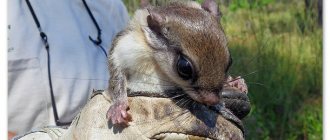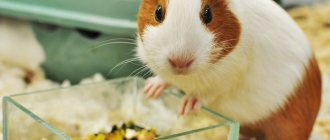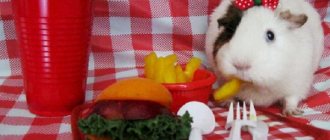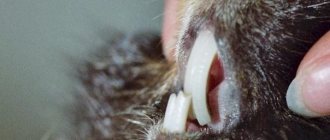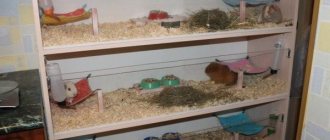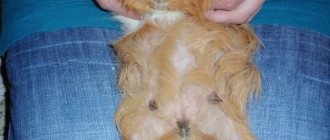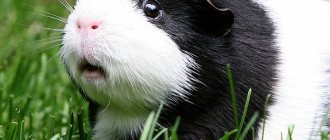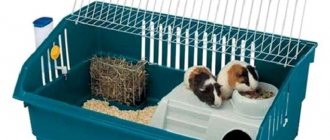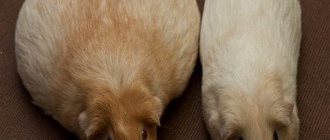Why were these animals called pigs? Perhaps because when they are calm, they grunt quietly, and when very frightened, they squeal like little piglets.
Guinea pigs are small rodents native to South America. They reach 24-30 centimeters in length and weigh from 700 to 1000 grams. They have 4 toes on their front paws and 3 toes on their hind paws. Like many other rodents, guinea pigs have 2 pairs of middle incisors, which constantly grow and sharpen themselves when worn. There are no fangs. There are significant gaps between the incisors and molars, which is typical for herbivorous mammals.
History of domestication of the guinea pig
The history of domestication of the guinea pig goes back more than seven thousand years. Before the invasion of the Spaniards, the Inca tribes developed several domestic breeds, from which all modern species and subspecies of cavia originated. However, the main criterion for breeders of the past was not color and intelligence, but the taste of meat and size. To this day, the tradition of eating guinea pigs has been preserved in Peru, Ecuador and China. In Europe and the USA, cavy meat is viewed with distrust: culinary specialists admit that it is tasty and has a pleasant aroma, but classify it as exotic.
According to information that has survived to this day, cavias arrived on the European continent at the end of the sixteenth century.
They quickly gained popularity due to their cute appearance, intelligence and wide variety of colors. They got their name for sounds and squeals similar to grunting, as well as for the proportions of the body and head. Guinea pigs were named because sailors took the animals with them on long voyages. The animals take up little space, eat simple plant foods and are very fertile, plus they are a source of valuable meat.
Appearance
If you look at a photo of a guinea pig in the wild, at first it may seem that this is an ordinary hare. He has the same gray color, with a slight touch of red, and cowardly behavior characteristic of our long-eared cats.
Although cowardice is not a bad trait, because pigs are hunted by many wild animals, from large birds of prey to wolves.
Red and gray colors are determined by living conditions. After all, there are grasses and rocks in the area. The pigs have fur that matches the color of the landscape, making it easier to hide. The animal has a very interesting fur structure. The hair itself is gray, has a red tint in the middle, and black at the tip.
The size of a guinea pig in the wild does not exceed 35 centimeters in length, and its weight does not exceed 3 kilograms. The animals have an elongated body, unlike domesticated ones. Therefore, there are much more external differences between domestic and wild animals than there are similarities.
Animals living in their natural environment are strong and hardy, weigh less and are very playful. Another cardinal difference is the color; in wild animals it is not so bright.
The life of guinea pigs in the wild occurs mainly at dusk. During the day they usually hide. And the “houses” are completely dependent on the environment. In mountainous areas this may be a crevice. On the plains, the animal digs minks, but more often it occupies the housing of other rodents, or creates a shelter of grasses and shrubs.
Guinea pigs tolerate sudden changes in temperature well. They are not afraid of cold temperatures down to +5 degrees and extreme heat when the air temperature rises to +45 degrees. In severe frosts, animals can die, which happens mainly with weak or too young individuals.
These are very clean representatives of wild fauna; they are almost completely odorless. They devote all their free time to cleaning their fur coats. Although this quality is associated not only with cleanliness, because the absence of smell makes it possible not to attract enemies again.
Appearance of pigs
A simple description of a guinea pig looks like this: a small animal with a cylindrical body, reaching a length of no more than thirty centimeters. An adult male weighs no more than two kilograms, and a female weighs about a kilogram. The head of the cavy is relatively large, the neck is poorly visible, and the legs are short. Distinctive features from the rodent order are manifested in the way the guinea pig looks, in its lifestyle, and in the duration of pregnancy. One of the most obvious distinguishing features is its very short ponytail.
In nature, they do not dig minks, but live on the surface, and pregnancy lasts up to seventy days.
However, like all representatives of rodents, caviae have a specific bite and pronounced long incisors. Incisors grow throughout their lives and it is very important to give them hard food to chew on, as well as tree branches so that the teeth can be worn down. Otherwise, excessively long teeth can damage the tongue, lips and palate. Even experienced breeders do not always know how many teeth a guinea pig has.
From birth, the animal has twenty teeth with a folded surface:
- two pairs of cuts,
- two pairs of premolars,
- three pairs of lower molars,
- three pairs of upper molars.
The animals also differ in color vision. They can distinguish yellow, green, red and blue colors, but guinea pigs have poor vision and rely little on their vision. The wild or natural color of pigs is close to black. All color forms existing today, as well as hairless and short-haired breeds, are obtained artificially.
Behavior and reproduction
Animals prefer to group in small flocks of 5 to 10 individuals; sometimes families with up to 20 members are found, but very rarely. In large flocks there is rarely peace, since in such groups there are many males who often “sort things out.” If the group is large, then this indicates that it has a strong leader.
While some of the members of the flock are feeding or sleeping, the other part is vigilant and warns of danger. Animals do not live alone, as they cannot survive without the help of their relatives.
Unlike their domestic counterparts, wild pigs are good swimmers. If necessary, they can swim across a small stream or river.
A guinea pig can sleep for only 10 minutes for several hours, and not always with its eyes closed. During this period of short sleep in animals, the brain is awake in order to instantly respond to danger.
Females give birth to offspring 2 times a year. Children acquire independence already at 6 or 7 days of age. Therefore, they leave their mother very quickly.
Coprophagous pigs
Animals that eat their own excrement are called coprophages. Pigs eat their droppings in a rather strange way: they curl up into a ball and swarm in the anus area, where the fecal pocket is located. Many breeders have a question: why do guinea pigs eat their litter and is it dangerous to health? Zoologists explain this behavior as follows: the pig’s body is not able to process all the amino acids contained in food. Some important amino acids and vitamins K and B leave the body along with feces. Even with vitamin supplements, the animal will continue to eat particles of droppings - there is no other way to obtain all the necessary amino acids.
In nature, pigs eat their droppings for another reason: they are very vulnerable and strive to destroy any traces of their vital activity so as not to attract the attention of predators.
Care and maintenance
Guinea pigs will need a comfortable and safe home, equipment and quality food.
Attention! When your pig arrives home, for the first couple of days she will look for a place to hide. It is better to give the animal time to adapt and not touch it.
Cage and filler
The animal can be kept in a cage, terrarium or enclosure. The main requirements for a guinea pig's home:
- availability of free space;
- design safety;
- good ventilation;
- ease of cleaning.
An aquarium or closed plastic cage is not a suitable option. There is poor air circulation in them. Some stores sell guinea pig racks. These are multi-tiered open-type structures with plastic pallets. They are somewhat reminiscent of a shop window. The floors are connected to each other by steps or gentle stairs with notches.
Such a dwelling does not take up much space in the apartment and is well ventilated. In addition, rodents living in these structures are constantly in sight of the owners, making it easy to observe them. The rack is easy to clean since the top is open.
Attention! It is important to choose the appropriate size cage or enclosure. This takes into account the number of adult rodents that will live there. At least 0.7 m2 should be allocated per individual.
A house for a guinea pig is placed in the cage. Each rodent should have its own shelter. It is quite large - approximately 35 cm in length, 20 cm in width and 7-10 cm in height. An adult animal must fit freely inside.
In addition, you will need a hay barn, 2 feeders and a drinking bowl. It is worth giving preference to the nipple one, since pets will not be able to knock it over, which means they will not be left without water.
Filler is used as bedding. Its function is to absorb moisture and eliminate unpleasant odors. For rodents, hardwood shavings or compressed sawdust are suitable.
Experts do not recommend installing a running wheel, as guinea pigs have a weak spine.
Hygiene
Caring for a common guinea pig includes cleaning the cage, brushing the fur, and trimming the nails. Inexperienced owners believe that rodents need to be bathed when they smell unpleasant. In fact, the animal washes its coat on its own. If an unpleasant odor appears, it means you need to change the filler in the cage more often. Guinea pigs are bathed in exceptional cases when it is impossible to remove dirt on the fur by other means.
The animal's home is cleaned every 4-7 days. The more pets live there, the faster the litter gets dirty. The dirty filler is thrown away and the tray is washed with hot water. Cleaning products must not be used.
It is necessary to periodically examine the animal's ears. If a lot of sulfur has accumulated in them, it is carefully removed with a cotton swab or disk. Claws are shortened once a month. Only the very tip is cut off with a special nail cutter.
It is imperative to monitor the condition of the fecal pouch in males. Sometimes shavings and other debris get into it, and droppings also accumulate. All this can lead to skin irritation and cause inflammation.
Taming
When the animal gets used to its new place of residence, you can begin to accustom it to your hands. The main thing in this matter is patience, there is no need to rush. First, the pig must get used to the owner's voice.
You need to approach the cage several times a day and talk affectionately to your pet. It is advisable to call him by name. Communication with a person should be associated with something pleasant, so you should treat the rodent with a piece of apple or carrot every time.
Then you can move on to the next stage - hand feeding. When the guinea pig stops being afraid, he will come closer and take the treat right from the palm. It is important not to make sudden movements so as not to scare her. Gradually, the animal will get used to the smell of the owner’s hands, and then it can be taken on your lap.
Lifestyle of pigs
In nature, guinea pigs are most active in the mornings and evening twilight. They are agile, can run fast and are always on the alert. You can see kavi in both mountainous areas and forests. Guinea pigs do not dig minks, preferring to build nests in a secluded place from dry grass, fluff and thin twigs.
The social lifestyle of guinea pigs involves living in one territory with a large flock of animals. Each pack or family consists of one male and ten or twenty females. In its natural habitat, a guinea pig eats roots and seeds of plants, leaves, fallen berries and tree fruits. The lifespan of wild cavy is no more than seven years.
At home, a guinea pig can live 12-15 years.
They are kept in ordinary cages, but are provided with sufficient walking: the animal is very active and needs movement. The constant activity of the animals raises the question among some breeders: how much guinea pigs sleep and whether they sleep at all. The animal sleeps for ten to fifteen minutes several times a day. The cubs sleep for less time. If the animal is worried or feels threatened, it may sleep with its eyes open.
There are four age stages in the life of Kavya. The first is under the mother, when the cub drinks the mother's milk. From the third day, the cubs begin to try adult food, but without milk the chances of survival are zero. The second period begins at the moment when the young individual switches to independent feeding and begins to eat all the basic adult food. At home, a grown guinea pig happily eats alfalfa or clover hay, young shoots of dandelions and clover, various root vegetables, fruits, and herbs. Of the roughage, pigs prefer to eat sprouted oats, wheat, and corn grains. The third period occurs during puberty. Females are ready for fertilization at the age of eight weeks, males at twelve weeks. The fourth period is characterized by a decrease in activity and loss of reproductive function.
Keeping at home
Breeders need to constantly monitor the animal's diet and how much the pig eats. Overeating, like fasting, has a negative impact on health. Another important point that every breeder should know is what foods should absolutely not be given to cavy. These include:
- red cabbage,
- sweets,
- meat products,
- fish products,
- eggs,
- dairy products.
Despite the fact that pigs are ready to breed at a very early age, it is recommended to get the first litter from one-year-old animals. By this age, they have time to fully grow, become stronger and take shape.
Frequently asked questions and answers:
Where did guinea pigs come from?
Guinea pigs originate from the Andes Mountains in South America, where they are treated as farm animals, like rabbits, and as food.
What breeds of pigs are there and how do they differ? Can they be identified only by appearance, or also by behavior?
- Short-haired pigs include: smooth-haired, rosette (Abyssinian), American Crested, English Crested, Rex, Teddy. Longhair breeds include Sheltie, Coronet, Angora, Peru, Texel, Merino, Alpaca and Mohair. All breeds have different colors.
- There are breeders who claim that there are visible differences not only in the appearance, but also in the behavior of individual breeds of pigs, but this has never been confirmed. Of course, a lot depends on the approach and breeding methods.
How long do guinea pigs live?
- Guinea pigs live relatively long: 5-8 years and even longer.
- The record holder was the pig Snowball from England, who lived for 14 years and 10 months. This record was included in the Guinness Book of Records.
Where is the best place to buy pigs and how do you know if they are healthy?
- It is best to get a guinea pig from a breeder.
- Don't be afraid to ask him specific questions. Any serious breeder will be happy to answer any question.
- You should also look inside the cages to make sure they are clean, spacious and bright, and that there are not too many pigs sharing the same cage.
- A healthy pet guinea pig has shiny fur and eyes and is not skinny.
- Her fur is not thin and does not tangle.
How to find out the gender of a guinea pig?
- This is not easy for the untrained eye.
- The sex of a pig is best diagnosed by comparing individuals of the same sex.
- To determine the sex, carefully pick up the guinea pig so its belly is visible.
- Then gently stretch the skin around your genitals with your fingers.
- If the organ looks like the letter “Y”, the pig is female, if it looks like the letter “I”, it is male.
What should your pet guinea pig eat every day?
- Your pet guinea pig should be given dry food, hay and fresh drinking water daily.
- In addition, vegetables and fruits will provide good nutrition. A guinea pig should not be fed rabbit food.
- Pigs are at risk of vitamin C deficiency because, like humans, they cannot produce it themselves. This vitamin is found in ready-made food for guinea pigs.
What should you not give your guinea pig to eat?
Expert opinion
Nastya Shulepina
I love helping animals and writing about them. Veterinary resuscitator.
Ask a Question
Under no circumstances should you give your guinea pig any sweets: ice cream, chocolates, sweets, etc., cabbage (causes flatulence)
How big should a cage be for two guinea pigs?
The smallest cage size for two animals is 100 x 60 cm. After all, pigs spend most of their time in a cage, so they need to be able to move around normally.
How to prepare a play area for a guinea pig?
For places where you can play, your imagination should have no boundaries - boxes, pipes, ramps. Your guinea pig will enjoy playing even more if there are small treats between the obstacles, such as a slice of cucumber, parsley root or a piece of paprika.
Can a guinea pig live outside?
Just like rabbits, in principle, a guinea pig can be kept in a cage outside. Guinea pigs should go outside anyway in the summer to properly shed their winter fur. In winter, the cage must be insulated and completely covered, for example, with plexiglass. An additional bedding of hay is also useful so that the animal can cover itself with it. Also, check your drinking water regularly to make sure it is not freezing.
What should you pay attention to when walking your pig outside?
- Please note that the street is sufficiently protected from dogs and cats.
- Never leave your pig on the ground while it is still cold or the grass is wet with dew.
- Your pig's first walks outside should not take too long to get him used to the grass and other outdoor vegetation and other inhabitants.
- It is best to feed frequently with green food from the very beginning.
How to pick up a guinea pig?
- To lift your guinea pig, it's best to use both hands and grab it in a criss-cross pattern under its belly.
- Then you can put it on your lap, or carry it on your chest.
- Be careful that the pig doesn't fall!
- She may look strong, but her bones are fragile.
- For example, falling off a sofa can cause serious injury.
How to make two guinea pigs friends with each other?
- The easiest way is to tame young animals to each other; with older ones this can be a little more difficult.
- To make them smell the same, you can lubricate them with fennel tea, then they should tolerate each other better.
- If you have two cages, you can keep them in separate cages next to each other for the first few days.
- Additionally, it is best to cage a newly purchased pig and then another pet in a regular cage to discourage them from being confident about their territory.
Can guinea pigs talk and what do their sounds mean?
- Guinea pigs make various sounds designed to attract the owner's attention.
- The most important one is the whistling sound that can be heard, especially when the guinea pig is enjoying the food being served.
- A guinea pig greets its human with a similar whistle.
- Another sound of pigs is a kind of “hum” that they make, for example, while petting their owner or during courtship.
- "Quileni" probably means sadness, but it is a mystery to experts who cannot explain how pigs make this sound.
- In addition, your pig may grind his teeth, which sounds a bit like growling.
- Grinding often happens when two men are arguing.
Is it possible to train a pig to be orderly?
There are guinea pigs that take care of their litter box needs like cats. To teach these animals such purity, training must begin at a very early age. Place your pig in the litter box, talk to her in a friendly manner, and pet her to create a positive association with the area.
How long can I leave my guinea pig alone?
- Sometimes long absences cannot be avoided.
- A guinea pig can be left alone for a maximum of two days as long as it is provided with sufficient food and drinking water.
My pig is not tamed, what should I do?
- Pay a lot of attention to this.
- Hand-fed treats such as fruits and vegetables can help with the taming process.
- You must be patient and devote time to your pet.
The nails are too long, how to trim them?
Because guinea pigs don't rub their nails well enough, they need to be trimmed regularly. You can take your pig to the vet, or do it yourself. Side cutters should cut the claw 3-5 mm in front of the innervated part. Light colored nails make it easy to see the nerves. Always trim dark nails from the very ends.
How to care for wool?
First of all, you should regularly check your fur for parasites. Firstly, long-haired pigs require regular grooming. They should be carefully combed with a soft brush. For curly coats, use your fingers to comb them gently so as not to hurt your pet with a harsh brush.
What to do if you have diarrhea?
Expert opinion
Nastya Shulepina
I love helping animals and writing about them. Veterinary resuscitator.
Ask a Question
In case of diarrhea, be sure to take your pig to the veterinarian because the pig has a very sensitive digestive system, the dysfunction of which can lead to serious intestinal damage.
The pig has an injured paw (a claw has broken off), what should I do?
It is best to dress the wound with a simple spray bandage to keep it clean. Then after some time the wound should heal without complications.
My pig's teeth seem too long, is this possible and what should I do?
In fact, some guinea pigs' teeth take too long to grow because they don't grind enough. Only a veterinarian can fix this. Pay attention to whether your pig is eating normally or whether food is not falling out of its mouth. Weigh your pig regularly (preferably once a week).
The pig throws food around, how to deal with it?
First of all, provide your pig with a stable and heavy bowl, such as for a rabbit. However, it should not be so large that your pig might mistake it for a litter tray.
What should I watch out for if I want to raise guinea pigs?
If you are thinking about starting a breeding farm, first consider what you will do with your mate's offspring. After all, a lot of domestic pigs are looking for a home and there is no one to care for them, as a result of which they end up in shelters or are simply thrown out.
- To get offspring of pigs, it is not enough just to let them get together. They should be closely monitored, weighed and fed carefully.
- After 68 days of covering, you can expect babies.
- After a maximum of four weeks, the young females must be separated from their father as he takes care of other offspring.
- A female for breeding should weigh around 700g and be between 5 and 11 months old when first mated. Before this, the pig's body was not yet developed - pregnancy can negatively affect its weight and height.
Interesting information about kavias
Interesting facts about guinea pigs are not limited to their differences from rodents and their relationship to coprophages:
- the distant ancestors of the guinea pig weighed more than 600 kg,
- Cavias have 64 chromosomes (humans have only 46),
- animals make many sounds. They can squeal, snort, grunt, chirp, purr, grumble,
- Kavyas cannot stand loneliness,
- their intelligence is slightly inferior to that of dogs and cats.
What is also interesting is what a guinea pig dreams about. According to dream books, if you dream about a guinea pig, this means that a person is not able to withstand the current circumstances and has low self-esteem. However, a guinea pig sitting in your arms portends joyful events and good news.
Relatives of Kavya
Relatives of guinea pigs include beavers, squirrels, and even gophers, mice and rats. Such a large number of relatives is explained by the large number of rodents.
Among the relatives of Cavia there are many familiar and many unusual mammals:
- mara looks like a hare, but larger - weight up to 16 kg,
- agouti is an animal that resembles both a rabbit and the ancient ancestor of modern horses,
- paka - a cautious and more deer-like rodent, weighing up to 12 kg,
- The capybara is the largest representative of the order, weighing up to 60 kg, grows up to 140 cm in length, and leads a semi-aquatic lifestyle.
